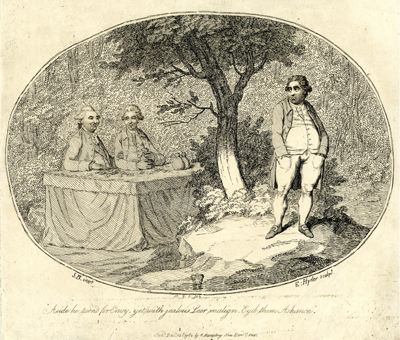Aside He Turn'd for Envy...
This is the second time in 1782 that Gillray implicitly compares Charles James Fox to the Satan of Milton's Paradise Lost. The first was Gloria Mundi, or the Devil Addressing the Sun in July which could be seen as a response to James Sayers' print, Paradise Lost.
In Sayers print, Fox and Burke were compared to Adam and Eve, banished from Paradise. But in Gloria Mundi Gillray had accurately identified Fox as someone more like Satan than Adam, someone motivated by hatred and envy, who tried and failed to overthrow the established order symbolized by Shelburne's sun.
In Aside He Turn'd... Fox is again seen as Satan, the full title of the print consisting of several lines from Book 4 of Paradise Lost when Satan comes upon Adam and Eve.
...aside the Devil turnd
For envie, yet with jealous leer maligne
Ey'd them askance, and to himself thus plaind.
Sight hateful, sight tormenting! thus these two
Imparadis't in one anothers arms
The happier Eden, shall enjoy thir fill
Of bliss on bliss, while I to Hell am thrust.

© Trustees of the British Museum
The scene is set amid an Edenic natural space. A tree that suggests the Tree of the Knowledge of Good and Evil emphatically divides the jealous Fox from the happy Shelburne and William Pitt.
Pitt had recently been named Chancellor of the Exchequer in the reconstituted Shelburne ministry, and appropriately holds a money bag before him while other coins litter the table. It is one of the first appearances in Gillray's work of the man who was to become Fox's arch-rival for most of the next twenty-four years. But whereas Gillray's portrayal of Fox is now approaching his mature style, he has yet to discover the formula for portaying Pitt, who looks nothing like the slim, pointed-nose figure of Gillray's later work.
But what is perhaps most striking about the print is the effort lavished upon the design, the figures, the foliage, and the drapery—the whole contained within an oval "frame" more often associated with the serious engraving of well-known paintings. Gillray has begun what was to become his life's work: the elevation of the satiric, caricature print to the status of a work of art.
Sources and Reading
- Commentary from the British Museum on Aside He Turn'd for Envy...
Comments & Corrections
NOTE: Comments and/or corrections are always appreciated. To make that easier, I have included a form below that you can use. I promise never to share any of the info provided without your express permission.